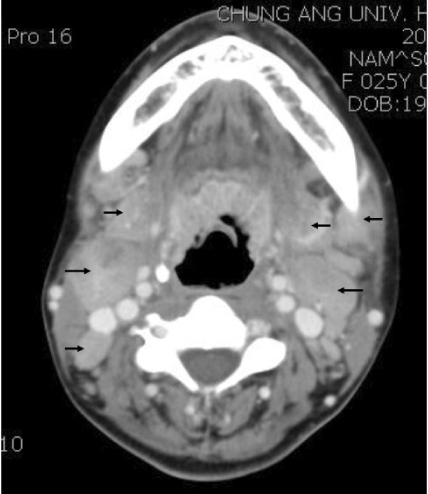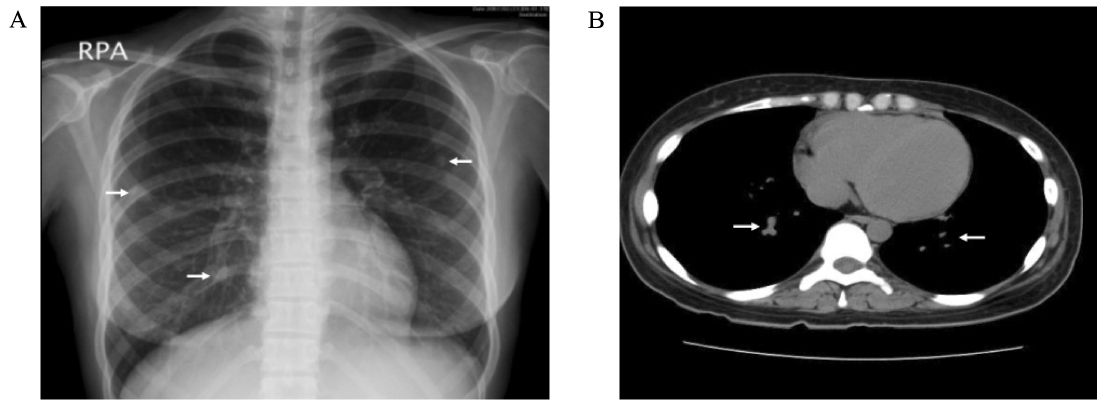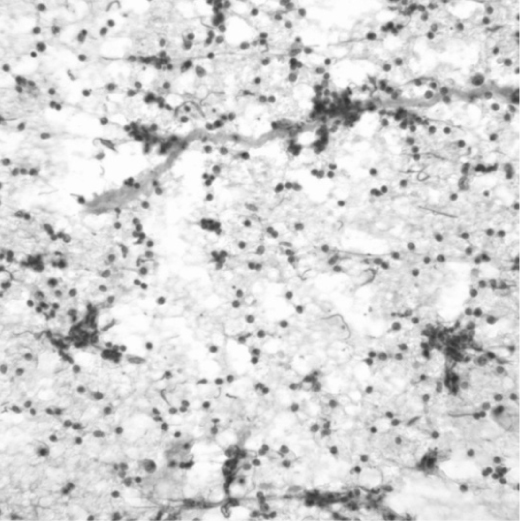J Korean Endocr Soc.
2008 Dec;23(6):420-424. 10.3803/jkes.2008.23.6.420.
A Case of Methimazole-induced Agranulocytosis and Kikuchi's Disease in a Patient with Graves' Disease
- Affiliations
-
- 1Division of Endocrinology, Department of Internal Medicine, Chung-Ang University College of Medicine, Seoul, Korea.
- KMID: 1965995
- DOI: http://doi.org/10.3803/jkes.2008.23.6.420
Abstract
- Methimazole-induced agranulocytosis is a rare, but critical side effect that should be recognized as soon as possible since it may induce a life-threatening condition when it was overlooked. Histiocytic necrotizing lymphadenitis is also called Kikuchi's lymphadenitis, and this is a rare form of lymphadenitis with a self-limited clinical course and this illness is accompanied by cervical lymph node enlargement, fever and malaise. We recently experienced a patient with methimazole-induced agranulocytosis and Graves' disease, and this was accompanied by Kikuchi's disease; the patient presented with sore throat and multiple enlarged cervical lymph nodes. To the best of our knowledge, there is no previous report on methimazole-induced agranulocytosis combined with Kikuchi's disease. Therefore, we report here on this very rare case along with a brief review of the relevant literature.
Keyword
MeSH Terms
Figure
Reference
-
1. Cooper DS. Antithyroid drugs. N Engl J Med. 1984. 311:1353–1362.2. Kikuchi M. Lymphadenitis showing focal reticulum cell hyperplasia with nuclear debris and phagocytosis. Nippon Ketsueki Gakkai Zasshi. 1972. 35:375–380.3. Andersohn F, Konzen C, Garbe E. Systematic review: agranulocytosis induced by nonchemotherapy drugs. Ann Intern Med. 2007. 146:657–665.4. Pearce SH. Spontaneous reporting of adverse reactions to carbimazole and propylthiouracil in the UK. Clin Endocrinol (Oxf). 2004. 61:589–594.5. Tamai H, Sudo T, Kimura A, Mukuta T, Matsubayashi S, Kuma K, Nagataki S, Sasazuki T. Association between the DRB1*08032 histocompatibility antigen and methimazole-induced agranulocytosis in Japanese patients with Graves' disease. Ann Intern Med. 1996. 124:490–494.6. Tajiri J, Noguchi S, Murakami T, Murakami N. Antithyroid drug-induced agranulocytosis. The usefulness of routine white blood cell count monitoring. Arch Intern Med. 1990. 150:621–624.7. Balkin MS, Buchholtz M, Ortiz J, Green AJ. Propylthiouracil (PTU)-induced agranulocytosis treated with recombinant human granulocyte colony-stimulating factor (G-CSF). Thyroid. 1993. 3:305–309.8. Fukata S, Kuma K, Sugawara M. Granulocyte colony-stimulating factor (G-CSF) does not improve recovery from antithyroid drug-induced agranulocytosis: a prospective study. Thyroid. 1999. 9:29–31.9. Sumiyoshi Y, Kikuchi M, Ohshima K, Takeshita M, Minematu T, Minamishima Y. Analysis of herpesvirus genomes in Kikuchi's disease. Virchows Archiv. 1994. 424:437–440.10. Kikuchi M, Yoshizumi T, Nakamura H. Necrotizing lymphadenitis: Possible acute toxoplasmic infection. Virchows Arch A Pathol Anat Histol. 1977. 376:247–253.11. Kuo TT, Lo SK. Significance of histological subtypes of Kikuchi's disease: comparative immunohistochemical and apoptotic studies. Pathol Int. 2004. 54:237–240.12. Abe Y, Ohshima K, Nakashima M, Hara K, Matsushima T, Choi I, Nishimura J, Kikuchi M, Nawata H, Watanabe T, Muta K. Expression of apoptosis-associated protein RCAS1 in macrophages of histiocytic necrotizing lymphadenitis. Int J Hematol. 2003. 77:359–363.13. Feller AC, Lennert K, Stein H, Bruhn HD, Wuthe HH. Immunohistology and aetiology of histiocytic necrotizing lymphadenitis. Report of three instructive cases. Histopathology. 1983. 7:825–839.14. Tsang WY, Chan JK. Fine-needle aspiration cytologic diagnosis of Kikuchi's lymphadenitis. A report of 27 cases. Am J Clin Pathol. 1994. 102:454–458.15. Mannarà GM, Boccato P, Rinaldo A, La Rosa F, Ferlito A. Histiocytic necrotizing lymphadenitis (Kikuchi-Fujimoto disease) diagnosed by fine needle aspiration biopsy. ORL J Otorhinolaryngol Relat Spec. 1999. 61:367–371.16. Choi G, Cho JH, Jung KY, Choi JO. Clinical considerations of Kikuchi's disease. J Clin Otolaryngol Head Neck Surg. 2000. 11:92–97.17. Jang YJ, Park KH, Seok HJ. Management of Kikuchi disease using glucocorticoid. J Laryngol Otol. 2000. 114:709–711.18. Kuo TT. Kikuchi's disease (histiocytic necrotizing lymphadenitis). A clinicopathologic study of 79 cases with an analysis of histologic subtypes, immunohistology, and DNA ploidy. Am J Surg Pathol. 1995. 19:798–809.19. Song YS, Kang SM, Ahn CW, Cha BS, Chang HS, Chung WY, Song YD, Lim SK, Kim KR, Lee HC, Park CS, Huh KB. A case of PTU (propylthiouracil)-induced agranulocytosis in Graves' disease: additional cases of antithyroid drug-induced agranulocytosis in Yonsei University Hospital last 10 years. Korean J Med. 2001. 60:398–403.20. Guffy MM, Goeken NE, Burns CP. Granulocytotoxic antibodies in a patient with propylthiouracil-induced agranulocytosis. Arch Intern Med. 1984. 144:1687–1688.
- Full Text Links
- Actions
-
Cited
- CITED
-
- Close
- Share
- Similar articles
-
- A Case of Acute Appendicitis in a Patient with Methimazole-Induced Agranulocytosis
- A Case of Agranulocytosis and Soft Tissue Abscess after Increasing Methimazole Dose in a Patient with Graves Disease under Long-term Mainternance Therapy
- Postinfectious Guillain-Barre syndrome in a patient with methimazole-induced agranulocytosis
- A case of Methimazole-Induced Cholestatic Jaundice With Agranulocytosis
- A Patient of Graves' Disease with Methimazole Induced Agranulocytosis Combined with Acute Appendicitis




